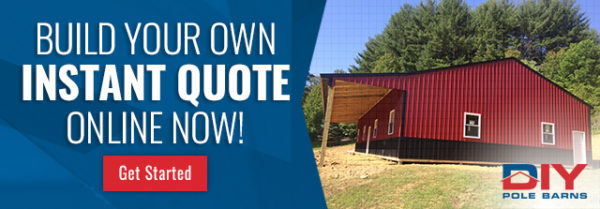Building a Pole Barn
Not every state, town, or city has the same regulations in regards to what a homeowner is permitted to build on his or her own property. Some towns require homeowners to adhere to certain codes and acquire special permits before they can build at all. Other towns may only require special permission if the building exceeds a certain size. Before building a pole barn home as a DIY project, it is smart to check with your town or city to find out what permits are required. Follow these guidelines in order to adhere to the building codes in your town.
Zoning
Before permits can be gathered and codes fulfilled, one must first find out if they are properly zoned to build. Sometimes, homeowners forget that they weren’t zoned to build agricultural-type buildings. A homeowner may still be able to acquire a building permit without actually being properly zoned for the project. When this happens, the town or city could easily ask that the new building be removed, even after permits are filed and granted. It is in the homeowner’s benefit to double check if they are properly zoned to build a barn home. Again, some towns and cities are stricter than others.
Permits
Since each city varies from the next, it is important to contact the town or city hall to find out what permits are required. Some towns will not care if the homeowner builds, as long as it is under a certain size, while others will require building permits for just about everything. It is the homeowner’s responsibility to find out if a permit is needed before building the pole barn home; one will not find any grace from city officials if a permit was not first obtained. A smart homeowner will make sure all required permits are obtained before building. It may sound like a pain, but doing so will save the homeowner from future stress and financial strain.
Land Usage
It is not enough to simply follow zoning regulations and apply for building permits; one must also make sure that the land he or she is building on is not protected. Sometimes land is protected by the state or federal government, meaning that even though it is privately owned, no permanent structures can be built upon it. Even after adhering to zoning and obtaining permits, if one builds on protected land, the government can ask that the building be removed. Land that is commonly protected usually falls under the following categories: marshlands, wetlands, animal preserves, and animal sanctuaries. The builder should check with the current national inventory of protected land to see if any property is currently protected.
Running Electricity to a Pole Barn
Running electricity to a newly-built pole barn is not as easy as plugging in some wires and then flicking on the switch. In fact, there are a few important details that must be considered before delivering power to any new structure. By taking some of the following into consideration, one can safely wire electricity to a newly built pole barn or garage.
Amps
Not every barn or garage will require the same amount of energy. If a pole barn or garage simply needs energy to power overhead lights, minimal energy is needed. On the other hand, if the newly erected pole barn will be used as living quarters or a place to use power tools, amp usage will undoubtedly be high. To find out how many amps needed for your application, divide the wattage by the voltage. Once the number of amps has been calculated, one can better decide on the best power driving method. Both methods will be discussed in the following paragraph.
Utility Company
The number of amps used to power the barn will have a direct effect on where the supplied energy comes from. If the number of amps is high, it is a far better idea to contact a local utility company and have them supply the energy directly. Also, if the pole barn or garage is not located anywhere near the house, direct energy from the utility company may be the best choice. If only minimum energy is needed and the distance between the house and the barn is not far, a homeowner may choose to wire energy directly from his or her home service panel. Doing so can be dangerous and tricky, and it is advised that the homeowner seek professional help if he or she is not fully confident in electrical work.
Codes and Regulations
If power will be supplied directly from the home service panel, the homeowner should strongly consider consulting a local electrical inspector. An inspector will be able to determine whether all codes and regulations are being met and will be able to advise how deep a trench the homeowner should dig when burying cables. Since all cables that carry electricity from a home to a secondary structure must be buried, one must know the regulations on depth and insulation before proceeding with the job. Contacting an electrical inspector is the easiest way to proceed.
Again, wiring electricity from the home to a garage or barn is a tricky and potentially dangerous job. It is advised that energy be supplied directly from a utility company; however, if a homeowner decides to wire electricity from the home, he or she should consult a professional before doing so.
All-in-all, building codes and regulations are established for your benefit. Contacting your local building department and code enforcement officials should never be avoided simply to save a little time or money. Although sometimes frustrating, you will be better off complying with the regulations set forth in order to have the safest possible project. And safety is always worth the effort.
If you’re ready to build your pole barn garage today, lock in a quote with DIY Pole Barns with our Instant Quote tool! Have questions? Call our knowledgeable staff at (937) 547-9100.




